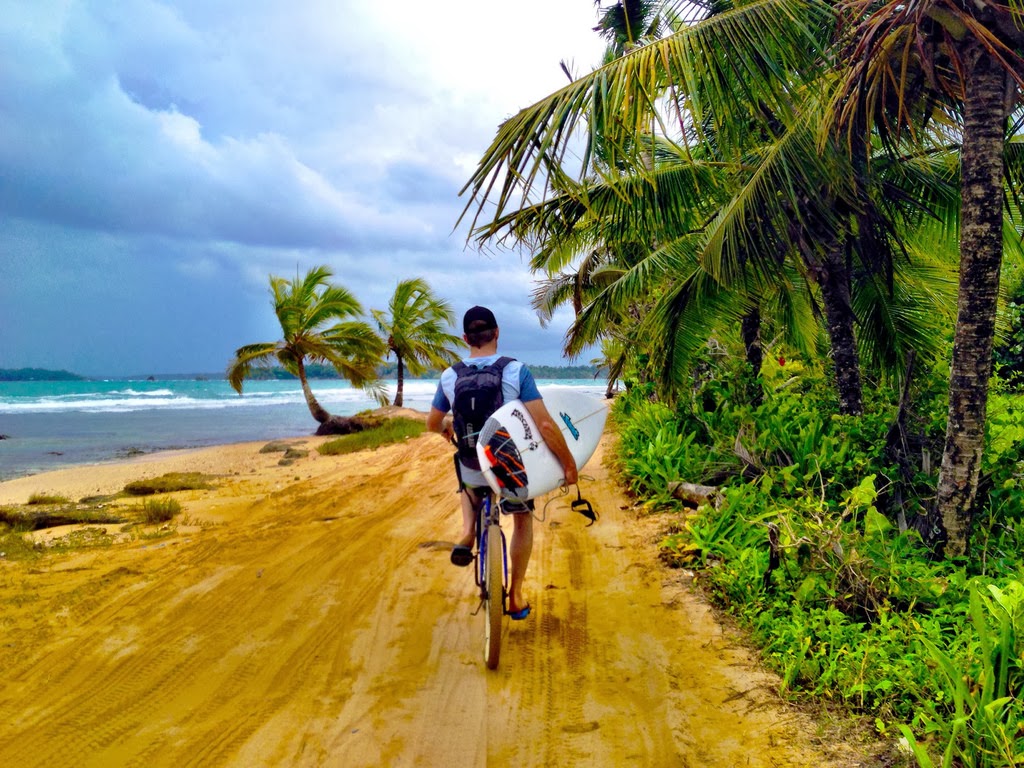We had heard a lot about chocolate farms in Panama and wanted to take time to check one out. All the websites and books mentioned the Oreba Chocolate Farm and how amazing the tours were there. We took a water taxi from Bocas Town and then a taxi from Almirante to the Oreba Plantation. The best part about the Oreba tour is that is entirely run by indigenous Ngabe Community and all the proceeds from the tours and chocolate go directly back into their community.
 |
| With our tour guide for the day, Jack |
 |
| With our walking sticks for the hike around the cacao plantation |
The tour starts with a hike around the plantation where you see all the fruit that they grow and learn about the chocolate farming business. The Ngabe Community actually supplies chocolate to Switzerland (Lindt), US, Germany and soon to be China too. It is now one of Panama's leading exports. Jack showed us all around the organic farm, explaining the process for growing the cacao at high altitudes (up on the hills), then the harvesting, fermenting, drying, roasting and then making the chocolate. I will include photos below from the rest of the tour and explain the process with the pictures. (since I know most of you are visual learners!)
- First we saw how the cacao fruit grows on the trees throughout the farm. I told you this stuff grows on trees! :) It takes about 3 years from planting a cacao tree to when you can harvest the fruit. After its starts, you can harvest the fruit every 15 days.
 |
| Cacao fruit growing on trees! |
- When they harvest the fruit every 15 days, they need to remove the 'beans' from the centre of each fruit. This plantation had over 40 different types of cacao fruit, so the colours of the skin ranged from yellow to red to purple.
- The inside of the fruit had huge beans that were covered in a fruity white coating. We all got to try a few of these and suck the fruit off of the beans. It was delicious! It tasted like a mango.
- The next two steps aren't pictured. First they have to ferment the beans in large wooden bins for 8 days. Next they have to dry the beans in huge solariums where it is extremely hot for 8-15 days (depending on weather)
- Next comes the roasting. You can see one of the Ngabe woman roasting the beans for us to try below.
- After they are roasted, most of it is sold to major chocolate manufacturers. For the portion that is sold locally, they then have to hand mash the roasted beans to form a chocolate paste.
- Below you can see the Ngabe woman using a rock to mash the cacao beans into chocolate. The rock she is mashing it onto is said to be over 500 years old. At this point, they let us take turns at mashing the beans, Nathan had a go at it and realized how hard it was!
- Here is a shot of the bowl of roasted cacao beans with the mashed chocolate paste.
- Now for the tasting! They mixed some of the chocolate paste with some sugar and heated it on the fire to give us a taste of the fresh chocolate. It was divine.
- After we saw the chocolate making process, we hiked back down the hill to experience a traditional Ngabe lunch. The lunch consisted of chicken (from their farm), elephant ears tube (which tastes like potato) and their leaves (mixed with garlic and tasted like spinach).
- At the end of the tour, you get to purchase some of their products made on the plantation. We bought some dark chocolate, hot choc mix, cooking chocolate and roasted beans. Our BIGGEST mistake was not buying more... the dark chocolate is to die for! Probably the best chocolate we have ever tasted. We are going to make Mole Chicken tonight and use the baking chocolate.
Here are some shots of the beautiful children of the Ngabe tribe:
The tour is $30 and you can learn more about the it here: Oreba Farm































